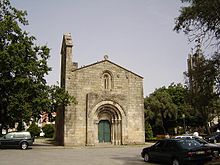- Church of São Martinho de Cedofeita
-
The Church of Cedofeita (Portuguese: Igreja de São Martinho de Cedofeita) is a mediaeval church in the city of Porto, in Portugal. It is located in the district of Cedofeita.
History
The Church of Cedofeita was built between the 12th and the 13th centuries in romanesque style. At least two previous buildings occupied the same place: one built around the 10th century, from which two pre-romanesque capitals are preserved in the interior, and another consecrated in 1098 by the Bishop of Braga, from which the lower part of the main chapel has survived.
The Church of Cedofeita was renovated in the 20th century, removing baroque additions and giving it a more "mediaeval" appearance.
Architecture and art
The nave of the church has only one aisle and one main chapel in the apse. The nave is covered by typical romanesque barrel vaulting. Cedofeita is the only romanesque one-aisled church in Portugal covered with a stone roof. The main chapel has a series of blind arches on the wall - a remnant from an earlier, 11th century building - and is illuminated by three narrow windows. Two capitals of the triumphal arch (between the main chapel and the nave) were reutilised from an ancient building, possibly a 10th century church in this same spot. These capitals, with sculptured vegetal motifs, are made of sandstone from the Coimbra region, which contrasts with the dark granite of the rest of the building. The nave is illuminated by the narrow windows on the nave and main façade and by a small rose window on the wall over the main chapel.
The main façade of the Church of Cedofeita has a romanesque, round-arched portal topped by a very narrow window that looks like an arrow slit. The tympanum of the main portal has a 18th century inscription, probably a copy of an earlier one, that tells that the church was founded in the 6th century. The main portal, as well as the lateral portals, have capitals with interesting romanesque motifs that reveal influences from the Cathedrals of Porto and Coimbra. The north portal has a tympanon with a relief of the Agnus Dei, the Lamb of God, a recurrent motif in Portuguese romanesque.
References
Categories:- Churches in Porto
- Romanesque architecture in Portugal
Wikimedia Foundation. 2010.


